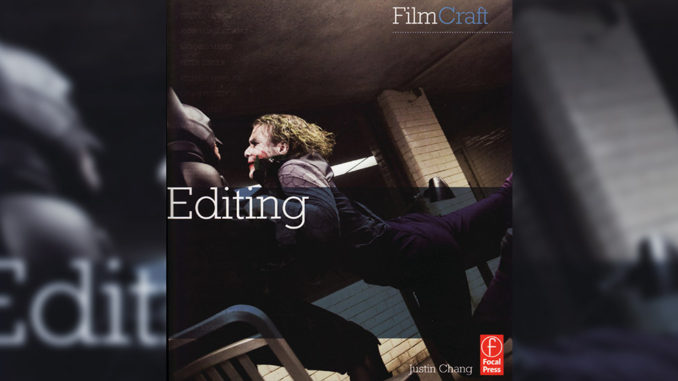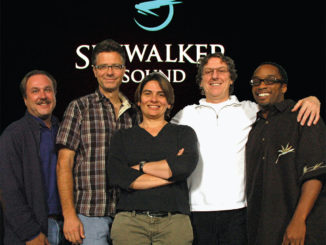
by Ray Zone
Film Editing (FilmCraft Series)
by Justin Chang
Focal Press
Paperbound, 192 pps., $29.95
ISBN: 978-0-240-81864-1
Focal Press has started to issue a new run of books in its FilmCraft Series. These are attractive, four-color volumes, reasonably priced, that provide definitive discussion of different aspects of moviemaking. Each book provides in-depth interviews with noted practitioners in the field. So far, this fine volume, Film Editing, by Justin Chang, a film reviewer at Variety, and a second volume, Cinematography, by Mike Goodridge and Tim Grierson have appeared in print.
Chang’s book on editing features interviews with 17 accomplished film editors. The interviews are broken up with sidebars on “Legacy,” featuring Peter Zinner; Dede Allen, ACE; Ralph E. Winters, ACE; Sally Menke, ACE.; and Barbara McLean. Sequential frame captures from films under discussion illustrate various cinematic moments and techniques of the interview subjects, who include Walter Murch, ACE, CAS, MPSE; Anne V. Coates, ACE., and Richard Marks, ACE., from the United States, Valdis Oskarsdottir from Iceland, William Chang Suk-ping from China and Herve de Luze from France, among quite a few others.
It is a “well-known axiom,” Chang writes in the Introduction, “that editing is the only cinematic discipline that did not precede the cinema itself.” Editing, in fact, is such an elusive art and craft to describe that even some of the most accomplished practitioners acknowledge how difficult it is to comprehend and discuss. “I can’t explain how I do what I do,” says Michael Kahn, ACE Coates states simply, “I just cut the way I feel.” Stephen Mirrione, ACE, editor of Swingers (1996) and Traffic (2000), says, “There is an alchemy in film editing that is difficult to articulate, partly because so few people are even aware of it.”
Not surprisingly, then, Chang opens his volume with the interview with Murch, who is nothing if not exact in the precision he uses to describe his work with both sound and picture editing. After acknowledging that cinema, after a hundred years of existence, is now pushing the “perceptual envelope” by driving the audience to “take in more information, faster,” Murch nevertheless states, “There is a limit.” To achieve temporal “density” of pacing and yet maintain narrative “clarity,” Murch has devised a general guideline. “My rule of thumb is generally not to present more than two-and-a-half thematic layers to the audience at any moment,” he says. So Murch will usually cut back and forth between two thematic layers and use a third one “coming in or going out” with “all of this shifting every 10 or 15 seconds.” He compares this to “a good shell game where the audience is kept guessing about where the pea is.”
“[Editing] is at the end of the assembly line. Nobody can change what I’ve done. Nobody can fix my mistakes. I like being the last man out.” – Tim Squyres, ACE
After working as a sound editor on The Godfather (1974) and American Graffiti (1973), Murch was recruited by Francis Ford Coppola to work as a supervising editor also on The Conversation (1974). “This is a film about sound,” Coppola told Murch. “You’re a sound person, and you’ve edited documentaries, so why don’t you edit the picture as well?” Murch has continued in dual capacities since that time. This merging of roles has been facilitated by digital technology, a disruption that has utterly changed the craft. Several of the editors interviewed in the book weigh in with their ambivalence about both the blessing and the curse that digital editing technology presents.
Marks, editor on The Godfather: Part II (1974) and supervising editor on Apocalypse Now (1979), relates how he adapted to digital technology. “It was difficult and clumsy,” he says. “I was computer-ignorant, so I wasn’t just adjusting to a new cutting system; I was adapting to this whole world of computers. Plus, the Avid was obviously not as sophisticated as it is now.” But with the process of editing, says Marks, “You have to be open to change. I mean, that’s what the process is all about.”
An interesting sidebar in the chapter with the Coates interview is about the decision of when to reveal the face of the title character in The Elephant Man (1980), in the feature directed by David Lynch and produced by Mel Brooks. Lynch wanted to show the head and face of the character early in the film but producer Brooks wanted to show it much later. Brooks eventually won out. And that created challenges for Coates, who had to cut away from or use other devices to not show the face until the climactic moment dictated by Brooks. “But this posed a major problem,” she says, “because we had already shot two or three scenes in between in which you saw the head, and so I had to recut those scenes so you didn’t see it — by losing a shot or two, or blowing up the shots until he was out of frame, or by making it so dark and grainy that you couldn’t see his face.”
Any film buff will enjoy this tome, but it will be a particular delight for editors to read these war stories from top professionals in the field. Tim Squyres, ACE, editor on The Wedding Banquet (1993) and Sense and Sensibility (1995), expresses a sentiment that all editors can appreciate when he says, “Early on, I realized that film editing was one of the best jobs in showbiz, because there are very few jobs, aside from writer or director, where you’re involved in telling the whole story.” Squyres enjoys being “at the end of the assembly line. Nobody can change what I’ve done. Nobody can fix my mistakes. I like being the last man out.”





